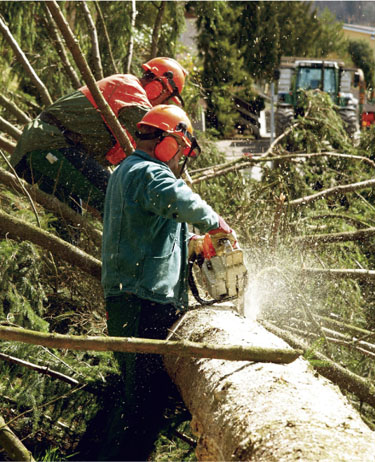 Even when an employer commits to a culture of safety, some jobs are just too dangerous to control all the inherent risks.
Even when an employer commits to a culture of safety, some jobs are just too dangerous to control all the inherent risks.
In these professions—think logging, mining, farming and roofing—accidents do happen, and the injuries are often very severe.
As such, these jobs are often deemed too risky to be placed in the private Workers' Compensation market, and so insureds must turn to state funds and pools—markets of last resort.
However, those in the industry with expertise in underwriting high-risk labor say turning a Workers' Comp profit in these problematic professions isn't as impossible as one might think.
But it isn't easy, either. After all, the Workers' Comp market in general—grouping so-called risky and nonrisky jobs together—has been operating at an unprofitable combined ratio above 100 for the last several years.
STEEP SLOPES AND CHAINSAWS
Logging ranks as one of the nation's most dangerous professions—enough so that it has inspired more than one reality television show starring the brave men and women who take on the trees.
“You quickly appreciate the dangers loggers face,” says Gary Ascher, president of Loggers Insurance Agency in Sparta, Wis.
Machinery, sharp blades, steep slopes, falling heavy timber and extreme weather constitute the working environment for loggers—one of the deadliest jobs out there, according to the U.S. Bureau of Labor Statistics.
“Slips and falls definitely outnumber everything claims-wise; there's a lot of logging done in the winter on uneven ground,” says Ascher. “But it's what else happens that puts it on the radar as one of the deadliest jobs—getting hit by a falling tree, for one.”
Ascher started as a commercial underwriter and eventually his business contacts introduced him to an intriguing niche: sawmills.
Insurers initially were not enthusiastic. “They said, 'No way!' when I brought it to them,” Ascher recalls. “I didn't want to give up. I knew it had more exposure than a typical machine shop, but well-run is well-run.”
 So Ascher says he recorded his potential clients at work, and he brought the video evidence to insurers and got one to write it.
So Ascher says he recorded his potential clients at work, and he brought the video evidence to insurers and got one to write it.
From that point on, securing policies for loggers was a natural progression.
Coverage from insurers “was fragmented,” he says, recalling his research nearly 20 years ago. “And [loggers] weren't reading the policies they were able to get. I was finding a lot of exclusions.”
Ascher developed a form and got an insurer, Secura, to come aboard.
“It can be done; it's expensive, but with a good safety history, there are markets that will take the risk,” he says. “A safe logger is just like a safe contractor, and the private markets take them on. It's a matter of underwriting.”
It helps that the logging industry as a whole is dedicated to safety and driven by regulation and human compassion, as many logging operations are family businesses spanning generations. It's a tight-knit community.
 Safety programs with an accompanying underwriter-valued “Master Logger Program” certificate are available, Ascher notes, in several states including Wisconsin, Kentucky, Florida, Maryland and Louisiana. Additionally, organizations such as the Vermont Division of Forestry, the Louisiana Logging Council, the Texas Logging Council and Maine's Certified Logging Professional Program offer underwriter-welcome safety courses.
Safety programs with an accompanying underwriter-valued “Master Logger Program” certificate are available, Ascher notes, in several states including Wisconsin, Kentucky, Florida, Maryland and Louisiana. Additionally, organizations such as the Vermont Division of Forestry, the Louisiana Logging Council, the Texas Logging Council and Maine's Certified Logging Professional Program offer underwriter-welcome safety courses.
New startups will have a tough time getting coverage from the private market and usually wind up in the state fund and pools, unless the owner has a good safety history with another outfit.
Similarly, chainsaw-loggers have a tougher time getting private-market coverage than mechanical logging, due to their greater number of injuries.
DIY SOLUTIONS, ANIMALS & MACHINERY BALE INTO BIG RISK
Farmers have made insurance-claims headlines this year due to weather—specifically, the severe drought that has affected much of the Midwest and its crops. But with its short-term employees, fix-it-yourself solutions, heavy equipment and the presence of large animals, every year farming faces the potential for high Workers' Comp losses.
 “There are such a large variety of duties on the farm,” says Kurt Eaves, vice president at Iowa's Grinnell Mutual Reinsurer, a reinsurer of 280 farm mutuals that picks up Workers' Comp. Many carriers, he notes, won't write Workers' Comp for farms because the business “lends itself to severity.”
“There are such a large variety of duties on the farm,” says Kurt Eaves, vice president at Iowa's Grinnell Mutual Reinsurer, a reinsurer of 280 farm mutuals that picks up Workers' Comp. Many carriers, he notes, won't write Workers' Comp for farms because the business “lends itself to severity.”
Many Workers' Comp claims from farms are generated by maintenance, says Eaves. Sometimes farmers “don't have the luxury of having the right equipment” or a tradesman on hand for a spur-of-the-moment repair situation.
That means a farmer might use a loader to get to heights, like a roof, or might do his best to fix an electrical problem on his own. These unorthodox measures can lead to injury.
Another source of farm claims: seasonal employees who aren't as experienced as full-time farmhands, says Eaves. Requirements to provide Workers' Comp for seasonal hires vary by state.
Dealing with machinery and ornery beasts adds to farms' high-risk status. “These are big, heavy animals,” he says. “You can get yourself in a very bad spot if you're not experienced.”
But for Grinnell, Eaves says, Workers' Comp for farmers “continues to be favorable. Like anything, it's about understanding the industry you're writing—and we've been entrenched in the rural marketplace for a long time.”
The best risks are selected by using site visits conducted by experienced loss-control staff, says Eaves. And, of course, a good loss history is important if a farmer is to stay out of state funds for Workers' Comp.
Grinnell assists farmers by providing risk-management advice, safety training and an accident-investigation program.
SEVERE LOSS HISTORY DRIVES ROOFERS' COVERAGE HIGHER
The higher the altitude at which you work, the riskier your position—so roofers are “definitely considered a high risk,” says Dean Mortilla of Woodbridge, N.J.-based NIP Group, a specialized business-insurance and risk-management intermediary. Mortilla is president of NIP's specialty brokerage.
The loss-severity history of roofers' Workers' Comp insurers, he says, is so bad that “some insurers won't touch it anymore—even if [the roofers] are two feet off the ground.
“Rates are up and carriers are out,” he adds, speaking of the current marketplace. “You can get it placed, but it's expensive. Carriers want their rate.”
Mortilla says he recently wrote Workers' Comp for a roofing operation in Michigan with payroll of just over $1 million for about $153,400—15 percent of payroll spent on Workers' Comp insurance.
Being placed under the classification of construction doesn't help roofers obtain Workers' Comp coverage—especially in New York, where new labor laws have driven claims costs up. California is another hard-to-place state.
What can roofers do to improve the chances they get coverage at a good rate?
“Have no losses,” Mortilla says flatly. “Have a safety program developed by a risk manager. Train employees on harnesses and hard hats.”
“Flukes” are acceptable, Mortilla says. That is, if a roofing business has a clear claims record for several years, it can likely stay in the private market after it has a loss.
“The insurers look for frequency,” he explains. “That's the sign something is wrong, and that business won't be able to get coverage.”
As the economy improves, Mortilla is seeing more submissions for coverage for new startups. However, they typically end up in the state funds due to the lack of loss history.
Startups “probably have to stay in [the state funds] for one to two years before they can get in the private market, but some stay even then because it's cheaper,” Eaves adds. “They don't care if the service stinks.”
EXPERT DIGGERS HELP SIZE UP MINING RISK
Another profession always on the “most-dangerous” lists is mining, but Chandler Cox says that while the fatal incidents get the headlines, “the number of fatalities has dropped dramatically over the last decade.
 “People have an image of what mining is, but it has evolved to become an automated, highly regulated industry,” adds Cox, president and CEO of American Mining Insurance, a W.R. Berkley company.
“People have an image of what mining is, but it has evolved to become an automated, highly regulated industry,” adds Cox, president and CEO of American Mining Insurance, a W.R. Berkley company.
Underwriting Workers' Comp for miners is all about understanding exposures—and there's no better way to do that than by hiring former mining foremen, says Cox: “They know how to size up the customer, talk the language and determine whether a mining operation is serious about safety or giving us lip service.”
Other than the risk of collapse, underwriters must find out about a mine's geology and roof supports, amount of methane gas and how it handles dust.
“Basically, we ask our people one question: Would you work in this mine?” Cox says. “If the answer is no, we won't touch it. Expertise matters. Loss control must be a critical part of the operation before we agree to insure it.”
If the mine asks for help in developing a loss-control plan, American Mining can provide it. And the industry has benefited enormously from regulations on the state and federal level.
“There are still many dangers, but the job is far safer than it was,” says Cox, who called mining safer than farming or the lumber industry.
For this reason, the market has become increasingly competitive, especially for surface mining, he adds.
Want to continue reading?
Become a Free PropertyCasualty360 Digital Reader
Your access to unlimited PropertyCasualty360 content isn’t changing.
Once you are an ALM digital member, you’ll receive:
- Breaking insurance news and analysis, on-site and via our newsletters and custom alerts
- Weekly Insurance Speak podcast featuring exclusive interviews with industry leaders
- Educational webcasts, white papers, and ebooks from industry thought leaders
- Critical converage of the employee benefits and financial advisory markets on our other ALM sites, BenefitsPRO and ThinkAdvisor
Already have an account? Sign In Now
© 2024 ALM Global, LLC, All Rights Reserved. Request academic re-use from www.copyright.com. All other uses, submit a request to [email protected]. For more information visit Asset & Logo Licensing.








